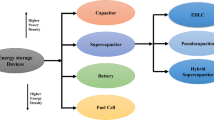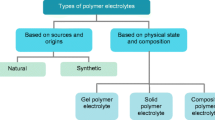Abstract
Thermally stable electrochemical devices are ideal due to their stabilized performance and longer service life at extreme temperatures. However, ageing in supercapacitors, which is caused by generation of heat induced by high voltage, current, temperature, and aided by temperature induced self-accelerating reactions, plague the performance and lead to shortened service life. Poly(N-isopropylacrylamide) (PNIPAM) has been one of the most studied temperature responsive polymers (TRPs) in the past decades; it has a lower critical solution temperature (LCST) around 32 °C. By integrating PNIPAM into aqueous electrolyte, it was found that once LCST is reached, the specific capacitance of supercapacitors is reduced, which is accredited to drag of ion migration and precipitated polymer chains reside upon electrode surface. The capacitance reduction is even more obvious when the electrolyte solute changed into large size solute potassium ferricyanide. In terms of specific capacitance, comparing to an increase of the control, the PNIPAM integrated systems experienced a decrease under 70 °C. The integration of TRPs into electrochemical systems offers alternative approach to suppress high temperature capacitive reactions and ageing, thus could guarantee longer service life, performance stabilized supercapacitors.





Similar content being viewed by others
References
P. Simon, Y. Gogotsi, B. Dunn, Where do batteries end and supercapacitors begin? Science 343, 1210–1211 (2014)
Z. Chen, P.-C. Hsu, J. Lopez, Y. Li, J.W.F. To, N. Liu, C. Wang, S.C. Andrews, J. Liu, Y. Cui, Z. Bao, Fast and reversible thermoresponsive polymer switching materials for safer batteries. Nat. Energy 1(1), 15009 (2016)
V. Augustyn, P. Simon, B. Dunn, Pseudocapacitive oxide materials for high-rate electrochemical energy storage. Energy Environ. Sci. 7(5), 1597 (2014)
R. Kötz, P.W. Ruch, D. Cericola, Aging and failure mode of electrochemical double layer capacitors during accelerated constant load tests. J. Power Sources 195(3), 923–928 (2010)
O. Bohlen, J. Kowal, D.U. Sauer, Ageing behaviour of electrochemical double layer capacitors. J. Power Sources 172(1), 468–475 (2007)
O. Bohlen, J. Kowal, S. Dirk Uwe, Ageing behaviour of electrochemical double layer capacitors: part II. Lifetime simulation model for dynamic applications. J. Power Sources 173(1), 626–632 (2007)
P. Azaïs, L. Duclaux, P. Florian, D. Massiot, M.-A. Lillo-Rodenas, A. Linares-Solano, J.-P. Peres, C. Jehoulet, F. Béguin, Causes of supercapacitors ageing in organic electrolyte. J. Power Sources 171(2), 1046–1053 (2007)
M.A. Stuart, W.T. Huck, J. Genzer, M. Muller, C. Ober, M. Stamm, G.B. Sukhorukov, I. Szleifer, V.V. Tsukruk, M. Urban, F. Winnik, S. Zauscher, I. Luzinov, S. Minko, Emerging applications of stimuli-responsive polymer materials. Nat. Mater. 9(2), 101–113 (2010)
X. Deng, Y. Chen, Z. Cheng, K. Deng, Z. Hou, B. Liu, S. Huang, D. Jin, J. Lin, Rational design of a comprehensive cancer therapy platform using temperature-sensitive polymer grafted hollow gold nanospheres: simultaneous chemo/photothermal/photodynamic therapy triggered by a 650 nm laser with enhanced anti-tumor efficacy. Nanoscale 8(12), 6837–6850 (2016)
S. Ashraf, H.-K. Park, H. Park, S.-H. Lee, Snapshot of phase transition in thermoresponsive hydrogel PNIPAM: role in drug delivery and tissue engineering. Macromol. Res. 24(4), 297–304 (2016)
S. Nagata, K. Kokado, K. Sada, Metal-organic framework tethering PNIPAM for ON–OFF controlled release in solution. Chem. Commun. 51(41), 8614–8617 (2015)
X.-Z. Zhang, X.-D. Xu, S.-X. Cheng, R.-X. Zhuo, Strategies to improve the response rate of thermosensitive PNIPAAm hydrogels. Soft Matter 4(3), 385 (2008)
H.G. Schild, Poly(N-isopropylacrylamide): experiment, theory and application. Prog. Polym. Sci. 17(2), 163–249 (1992)
M. Heskins, J.E. Guillet, Solution properties of poly(N-isopropylacrylamide). J. Macromol. Sci.-Chem. 2(8), 1441–1455 (1968)
G. Zhang, C. Wu, Quartz crystal microbalance studies on conformational change of polymer chains at interface. Macromol. Rapid Commun. 30(4–5), 328–335 (2009)
Y. Zhang, S. Furyk, L.B. Sagle, Y. Cho, D.E. Bergbreiter, P.S. Cremer, Effects of Hofmeister anions on the LCST of PNIPAM as a function of molecular weight. J. Phys. Chem. C 111, 8916–8924 (2007)
X. Zhu, C. Yan ,F.M. Winnik, D. Leckband, End-grafted low-molecular-weight PNIPAM does not collapse above the LCST. Langmuir 23, 162–169 (2006)
K.N. Plunkett. X. Zhu, J.S. Moore, D.E. Leckband, PNIPAM chain collapse depends on the molecular weight and grafting density. Langmuir 22, 4259–4266 (2006)
Y. Zhang, S. Furyk, D.E. Bergbreiter, P.S. Cremer, Specific ion effects on the water solubility of macromolecules: PNIPAM and the Hofmeister series. J. Am. Chem. Soc. 127, 14505–14510 (2005)
A. Hijazi, P. Kreckzanik, E. Bideaux, P. Venet, G. Clerc, M. Di Loreto, Thermal network model of supercapacitors stack. IEEE Transac. Ind. Electron. 59 (2):979–987 (2012)
L. Sheeney Haj Ichia, G. Sharabi, I. Willner, Control of the electronic properties of thermosensitive poly(N-isopropylacrylamide) and Au-nano-particle/poly(N-isopropylacrylamide) composite hydrogels upon phase transition. Adv. Func. Mater. 12(1), 27–32 (2002)
Y. Shi, H. Ha, A. Al-Sudani, C.J. Ellison, G. Yu, Thermoplastic elastomer-enabled smart electrolyte for thermoresponsive self-protection of electrochemical energy storage devices. Adv. Mater. 28(36), 7921–7928 (2016)
H. Yang, Z. Liu, B.K. Chandran, J. Deng, J. Yu, D. Qi, W. Li, Y. Tang, C. Zhang, X. Chen, Self-protection of electrochemical storage devices via a thermal reversible sol-gel transition. Adv. Mater. 27(37), 5593–5598 (2015)
J.C. Kelly, D.L. Huber, A.D. Price, M.E. Roberts, Switchable electrolyte properties and redox chemistry in aqueous media based on temperature-responsive polymers. J. Appl. Electrochem. 45(8), 921–930 (2015)
J.C. Kelly, M. Pepin, D.L. Huber, B.C. Bunker, M.E. Roberts, Reversible control of electrochemical properties using thermally-responsive polymer electrolytes. Adv. Mater. 24(7), 886–889 (2012)
J.C. Kelly, R. Gupta, M.E. Roberts, Responsive electrolytes that inhibit electrochemical energy conversion at elevated temperatures. J. Mater. Chem. A 3(7), 4026–4034 (2015)
X. Wang, X. Qiu, C. Wu, Comparison of the coil-to-globule and the globule-to-coil transitions of a single poly(N-isopropylacrylamide) homopolymer chain in water. Macromolecules 31(9), 2972–2976 (1998)
G. Perenlei, T.W. Tee, N.A. Yusof, G.J. Kheng, Voltammetric detection of potassium ferricyanide mediated by multi-walled carbon nanotube/titanium dioxide composite modified glassy carbon electrode. Int. J. Electrochem. Sci. 6, 520–531 (2011)
H. Yang, W.R. Leow, X. Chen, Thermal-responsive polymers for enhancing safety of electrochemical storage devices. Adv. Mater. 30, e1704347 (2018)
J. Shen, K. Han, E.J. Martin, Y.Y. Wu, M.C. Kung, C.M. Hayner, K.R. Shull, H.H. Kung, Upper-critical solution temperature (UCST) polymer functionalized graphene oxide as thermally responsive ion permeable membrane for energy storage devices. J. Mater. Chem. A 2(43), 18204–18207 (2014)
Acknowledgements
The authors would like to thank Ms. Kim Ivey for assistance with GPC measurement and the Department of Materials Science and Engineering and the Department of Chemical and Biomolecular Engineering of Clemson University for funding support.
Author information
Authors and Affiliations
Corresponding author
Additional information
Publisher’s Note
Springer Nature remains neutral with regard to jurisdictional claims in published maps and institutional affiliations.
Electronic supplementary material
Below is the link to the electronic supplementary material.
Rights and permissions
About this article
Cite this article
Jiang, H., Roberts, M.E. Achieving thermally stable supercapacitors with a temperature responsive electrolyte. J Mater Sci: Mater Electron 30, 6007–6014 (2019). https://doi.org/10.1007/s10854-019-00900-5
Received:
Accepted:
Published:
Issue Date:
DOI: https://doi.org/10.1007/s10854-019-00900-5




